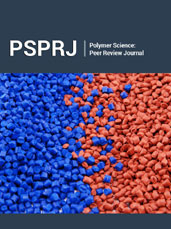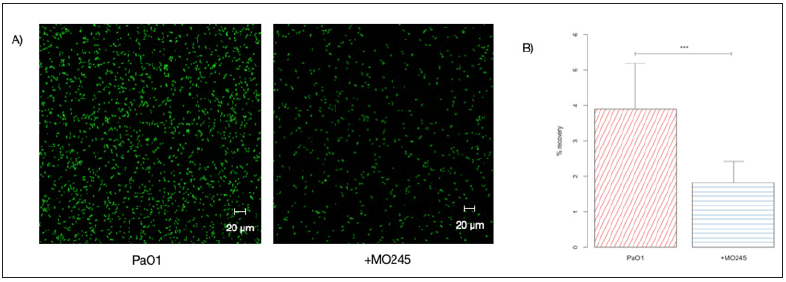- Submissions

Full Text
Polymer Science: Peer Review Journal
Research for the Development of New Anti- Bio Adhesive Coatings: The Strategy of Exopolysaccharides
Faÿ F1*, Champion M1, Portier E1, Moppert X2, Linossier I1 and Réhel K1
1Laboratory of Biotechnology and Marine Chemistry-EA3884, European University Institute of the Sea, Université Bretagne Sud, France
2Pacific Biotech BP 140 289 Arue Tahiti (French Polynesia), France
*Corresponding author: Fabienne Faÿ, Laboratory of Biotechnology and Marine Chemistry-EA3884, European University Institute of the Sea, Université Bretagne Sud, Lorient,France
Submission: November 27, 2020;Published: January 08, 2021

ISSN: 2770-6613 Volume1 Issue4
Opinion
Marine biofouling is a natural process, which is initiated by the adsorption of organic
and mineral molecules, followed by the adhesion of microfouling (bacteria and microalgae
principally) and macrofouling (macroalgae and invertebrates). Biological fouling can bring
about some unwanted and detrimental economic and environmental consequences to marine
surfaces. Several ways to combat against fouling have been developed. Most of them include the
use of polymeric coatings blended with metals as copper and/or toxic organic compounds. For
almost 50 years, commercial antifouling (AF) paints used tributyltin (TBT), a broad-spectrum
biocide formulated in copolymer paints with cuprous oxide. Unfortunately, paints are highly
toxic for many aquatic organisms and severe toxic effects on marine ecosystems have been
observed. In 2008, the use of TBT was banned. Today, coatings are formulated by using copper
(CuSCN, Cu2O or Cu metal) and organic molecules called booster biocides. Nevertheless, these
solutions are not environmentally satisfactory and the recent regulation concerning the use of
biocidal agents (EU Regulation No 528/2012 known as Biocidal Product Regulation) requires
a higher level of environmental protection. The current research of environmentally friendly
marine antifouling coatings relate the use of biodegradable polymers to control erosion
and bioactive molecules released, and natural products as bioactive ingredients [1]. Natural
products from marine organisms can be used as replacements for the biocides commonly
used in AF coatings [2]. Many sessile marine animals are free from biofouling and produce
metabolites that demonstrate antifouling properties. AF substances have been extracted
from a variety of marine organisms: micro-organisms (marine bacteria, fungi, cyanobacteria),
seaweeds, aquatic plants and marine invertebrates. Different modes of actions are known
inhibitor of adhesive production/release, biofilms inhibitors, quorum sensing blockers,
protein expression regulators, blockers of neurotransmission or surface modifiers. However,
the main difficulties are their expensive cost, their large-scale production, the maintain of
their activity after formulation in paint and to retain their activity for a long time.
For innovative and ecological solution to marine biofouling, it is necessary to shift the
research strategy to new approaches combining surfaces properties and novel surface
preventing bio adhesion or promoting release [3]. Polydimethylsiloxane and fluoropolymers
surfaces are an approach without biocide. The combination of low surface free energy, low
roughness, and low elastic modulus together lead to low interfacial bond between organisms
and the coating. Even if organisms attach on the surface, only a weak dispersive interaction
will take place, resulting in the easy removal of the organisms. This concept is one of the
promising antifouling alternative strategies. However, their no-toxicity remains questionable
because their efficiency relies on the addition of oil. It has been reported that these “oils” are
usually block copolymers that can migrate through the coatings to function as surfactants
and silicone have been classified as hazardous substances [4]. Their inert oily nature and
relative extreme persistence are a potential threat to aqueous environments. Moreover, compared with other coatings, they are more vulnerable to damage.
Biomimetic antifouling coatings are microstructure surfaces [5].
Their mechanisms of action are to destroy the physical attachment
of organisms. Their surfaces are similar to the microstructure
contained in the biological epidermis (skin of surface of sharks,
shells…). The current methods of concepting these microstructure
surfaces include photolithography, laser etching, micro-contact
printing, three-dimensional printing, picosecond laser texturing
[6]. However, the construction and the repair of such surfaces
is complicated, and their efficiency is limited in real marine
environment due to the large scale of topography to be achieved
(from a few μm to several hundred μm).
For all these reasons, novel and environmentally friendly
antifouling coatings are needed and the use of polysaccharides
could be the key to an original strategy. Polysaccharides are
widely distributed in the nature. They have a number of
characteristics such as biocompatibility and biodegradability and
may be commercially available. Among these polymers, bacterial
extracellular polysaccharides (EPS) display antibiofilm properties
with interesting modes of action. Their antibiofilm activity is due to
mechanisms other than bacteriostatic or bactericidal activity [7,8].
Most of them act as surfactant molecules. Bacterial EPS modify the
physical properties of abiotic as well as cell surfaces. In addition to
inhibiting intercellular adhesion, bacterial EPS have been shown to
inhibit binding of bacterial cells to various biotic surfaces. They may
act as an interspecies cell-to-cell signal that downregulates biofilm
formation. Moreover, several bacterial EPS might inhibit and/or
destabilize the biofilm. Hence, surface treatment by bacterial EPS
and bacteria-repellant coatings are promising approaches [9].
Among the several genus of bacteria that produce EPS, Vibrio is
one of the more widespread [10]. A bacterium from Vibrio genus
was isolated from bacterial Mats in the lagoon of Moorea Island
(French Polynesia) and it is referred to as strain MO245. During
stationary phase of growth, the isolated MO245 strain produces
an exopolysaccharide (EPS) characterized by equal amounts of
glucuronic acid and hexosamines (galactosamine and glucosamine
in the same proportion) with a molecular weight (Mw) of 513kDa
average. It is a weak polyelectrolyte with similar conformational
and physico-chemical properties than hyaluronic acid, a known
antibiofilm polysaccharide [11].
The bioactivity of EPS from MO245 have been shown against
a pathogenic bacteria Pseudomonas aeruginosa PAO1. Until
500μg/mL, no bacteriostatic or bactericide activities have been
observed: the polymer is not toxic against Pseudomonas aeruginosa.
However, the impact of EPS from MO245 (125μg/mL) on adhesion
of Pseudomonas aeruginosa PaO1 on glass surface at ambient
temperature clearly shows an inhibition of adhesion. Confocal laser
scanning microscopy observations show a significant decrease
(p<0,001) of cells adhesion in the presence of EPS compared to the
control without EPS (Figure 1): the percentage of adhered cells on
the glass surface decrease from (3,90%) to (1,81%) without and
in the presence of EPS respectively [12]. The potential mechanism
of EPS from MO245 concerns an anti-adhesive effect rather than a
biocidal effect. Hence, the conception of biobased coatings based
on EPS could be an interesting approach in the development
of new strategies fighting antibiofilm and antifouling. Indeed,
the antifouling efficiency of bacterial EPSs have already been
highlighted in natural environment as seawater [13].
Figure 1: Impact of EPS from MO245 ((125μg/mL) on adhesion of Pseudomonas aeruginosa PaO1 on glass
surface at room temperature (Protocol from [12]).
A) Top view of Pseudomonas aeruginosa PaO1gfp adhesion observed by CLSM (lexcitation: 488nm, lemission:
500-584nm).
B) Recovery percentage of Pseudomonas aeruginosa PaO1 adhesion analysis by Image J. ***p.value<0,001 (Man
Whitney test).

References
- Faÿ F, Gouessan M, Linossier I, Réhel K (2019) Additives for efficient biodegradable antifouling paints. International Journal Molecular Sciences 20: 361.
- Qian PY, Xu Y, Fusetani N, Li Z, Li Y (2015) Mini-review: Marine natural products and their synthetic analogs as antifouling compounds: 2009-2014. Biofouling 31(1): 101-122.
- Gu Y, Yu L, Mou J, Wu D, Xu M, et al. (2020) Research strategies to develop environmentally friendly marine antifouling coatings. Marine Drugs 18(7): 371.
- Camos Noguer A, Olsen SM, Hvilsted S, Kiil S (2017) Field study of the long-term release of block copolymers from fouling release coatings. Progress in Organic Coating 112: 101-108.
- Yan H, Wu Q, Yu C, Zhao T, Liu M (2020) Recent progress of biomimetic antifouling surfaces in marine. Advanced Materials Interfaces 7(20): 2000966.
- Richards C, Slaimi A, O Connor NE, Barrett A, Kwiatkowska S, et al. (2020) Bio-inspired surface texture modification as a viable feature of future aquatic antifouling strategies: A review. International Journal of Molecular Sciences 21(14): 5063.
- Bernal P, Llamas MA (2012) Promising biotechnological applications of antibiofilm exopolysaccharides. Microbial biotechnology 5: 670-673.
- Rendueles O, Kaplan JB, Ghigo JM (2013) Antibiofilm polysaccharides. Environmental Microbiology 15(2): 334-346.
- Junter GA, Thébault P, Lebrun L (2016) Polysaccharide-based antibiofilm surfaces. Acta Biomaterialia 30: 13-25.
- Guezennec J, Moppert X, Raguénès G, Richert L, Costa B, et al. (2011) Microbial mats in French Polynesia and their biotechnological applications. Process Biochemistry 46(1): 16-22.
- Martin Pastor M, Ferreira AS, Moppert X, Nunes C, Coimbra M, et al. (2019) Structure, rheology, and copper-complexation of a hyaluronan-like exopolysaccharide from Vibrio. Carbohydrate Polymers 222: 114999.
- Le Norcy T, Niemann H, Proksch P, Tait K, Linossier I, et al. (2017) Sponge-inspired dibromohemibastadin prevents and disrupt bacterial biofilms without toxicity. Marine Drugs 15(7): 222.
- Guezennec J, Herry JM, Kouzayha A, Bachere E, Mittelman MW, et al. (2012) Exopolysaccharides from unusual marine environments inhibit early stages of biofouling. International Biodeterioration and Biodegradation 66(1): 1-7.
© 2021 Fabienne Faÿ. This is an open access article distributed under the terms of the Creative Commons Attribution License , which permits unrestricted use, distribution, and build upon your work non-commercially.
 a Creative Commons Attribution 4.0 International License. Based on a work at www.crimsonpublishers.com.
Best viewed in
a Creative Commons Attribution 4.0 International License. Based on a work at www.crimsonpublishers.com.
Best viewed in 







.jpg)






























 Editorial Board Registrations
Editorial Board Registrations Submit your Article
Submit your Article Refer a Friend
Refer a Friend Advertise With Us
Advertise With Us
.jpg)






.jpg)














.bmp)
.jpg)
.png)
.jpg)










.jpg)






.png)

.png)



.png)






